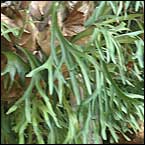Staghorns and elkhornsFerns of distinction — home gardeners look to exotic ferns for impact. Stags and elks have minimal root systems (just enough to anchor them to the tree) but they have adapted to catch leaves, debris and rainwater falling from above. Unlike most other plants, which absorb water and nutrients through their roots, these ferns can only survive if they capture sufficient quantities of moisture and nutrients from the surrounding air. So how do we grow them in the garden? Well, success depends on recreating the conditions these plants enjoy in the wild:
Happy staghorns and elkhorns are usually relatively free of pests and diseases but they can suffer attack by scale insects and slugs and snails. Slugs and snails chew holes in the ferns and leave behind those characteristic slimy trails. A sprinkling of snail pellets on top of the organic matter in the back of the fern will discourage most of these mollusc pests. Snails and slugs are active at night so they can often be captured by hand with the help of a torch. Use scissors to trim the damaged fronds. Treat sap-sucking scale insects by applying a low toxic systemic spray, such as Confidor. Spray thoroughly over the leaf surfaces and saturate the stored organic matter. Don't worry about large brown felty patches that develop beneath the fronds: these are the spores, the dust-like particles that are the reproductive stages of these exotic plants' life cycles.
|
Home | Journal
| Newsletter | Conferences
Awards | Join
RNZIH | RNZIH Directory | Links
© 2000–2025 Royal New Zealand Institute of Horticulture
Last updated: June 2, 2004


 Staghorns and elkhorns are some of the most amazing-looking plants,
and despite their exotic appearance they are relatively easy to
grow. The reason they look so different from most other plants is
that they have adapted to survive in the treetops. Stags and elks
are epiphytic, which means that they grow on trees.
Staghorns and elkhorns are some of the most amazing-looking plants,
and despite their exotic appearance they are relatively easy to
grow. The reason they look so different from most other plants is
that they have adapted to survive in the treetops. Stags and elks
are epiphytic, which means that they grow on trees.